
Click the name of a planet to learn more about its visibility in November 2020: Jupiter, Saturn, Mars, Venus, Mercury
Try Stellarium for a precise view of the planets from your location.
Want precise planet rise and set times? Click here for recommended almanacs

Depending on where you live on Earth’s globe, the October 31 full moon will be either the second of 2 October full moons (most everywhere worldwide) or the first of 2 November full moons (Eastern Australia and New Zealand). The second of 2 full moons in a single calendar month is called a Blue Moon. Read more.

The first few weeks in November 2020 present a grand time to catch the planet Mercury beneath the brightest planet of them all: Venus. Read more.
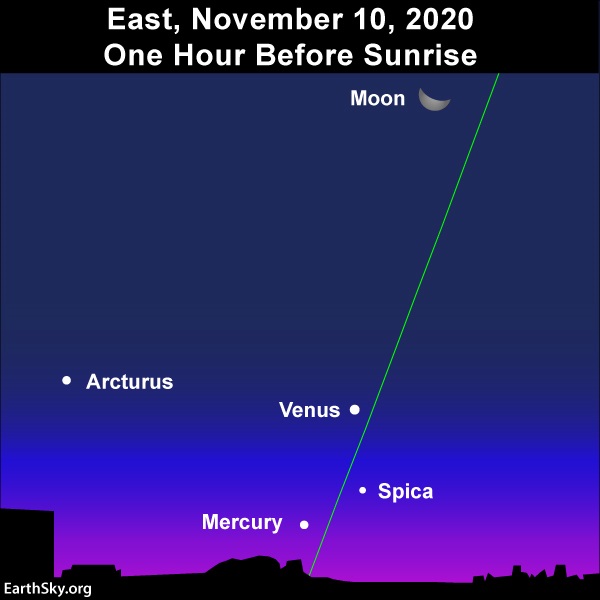
Starting around November 10, 2020, the illuminated side of the waning crescent moon points to the two morning planets, Venus (at top) and Mercury (at bottom). Read more.

The waning crescent moon won’t ruin the North Taurid meteor shower on the expected peak night of November 11-12, 2020. But it’ll certainly be a treat to view the slender waning crescent moon with the planets Venus and Mercury! Read more.
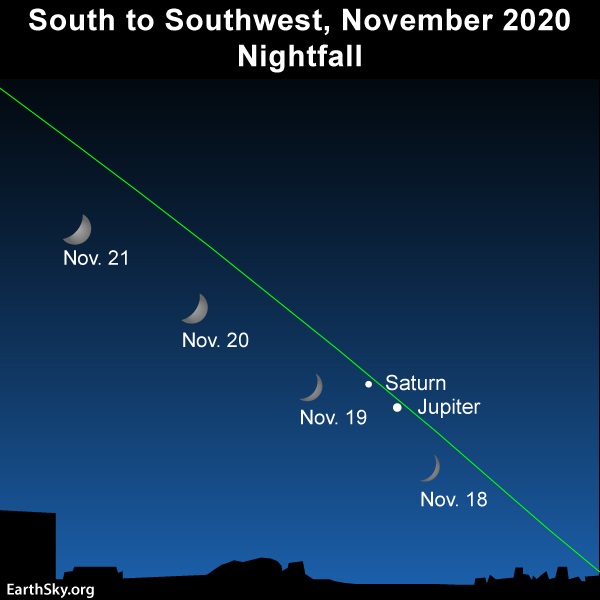
Watch for the waxing crescent moon to shine in the neighborhood of Jupiter and Saturn for several days, centered on or around November 19, 2020. Read more.
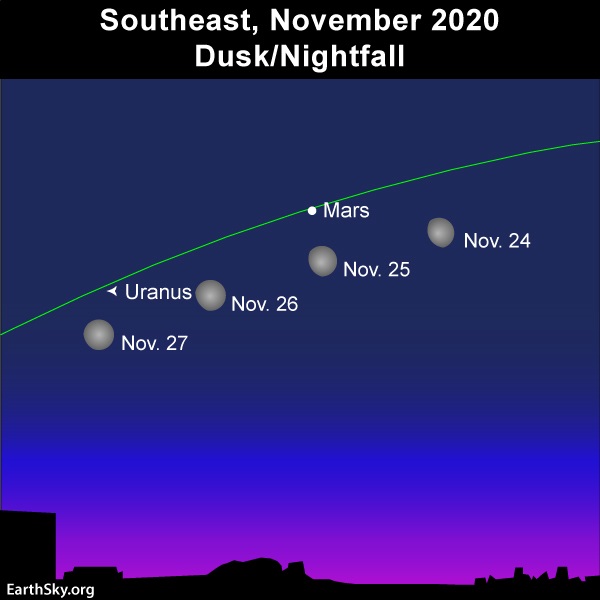
Use the bright waxing gibbous moon to locate Mars for several nights, centered on or near November 25, 2020. Read more.
Jupiter and Saturn come out first thing at nightfall in November 2020, and will continue to do so until the year’s end. They are near one another on the sky’s dome, with Saturn following Jupiter westward across the sky from nightfall until their setting below the southwest horizon.
At mid-northern latitudes, Jupiter and Saturn set at mid-evening; and from the Southern Hemisphere, they stay out till late night.
For the first time since the year 2000, Jupiter and Saturn will have a great conjunction this year, in December 2020. Great conjunctions of these two giant worlds happen every 20 years, but this year’s event will be the closest of Jupiter-Saturn conjunctions since the year 1623. Astronomers use the word conjunction to describe meetings of planets and other objects on our sky’s dome. They use the term great conjunction to describe a meeting of Jupiter and Saturn. The last great Jupiter-Saturn conjunction was May 28, 2000. The next one will be December 21, 2020. Watch for these worlds to edge closer and closer together throughout November 2020.
Read more: Before 2020 ends, a great conjunction for Jupiter and Saturn
These two worlds appear bright and beautiful throughout November. Day by day, they’ll sink a bit lower in the sky at sunset, and set sooner after dark.
If you have a telescope, it’s best to use it when Jupiter and Saturn are highest up for the night at nightfall. These two worlds will descend westward as evening deepens, so catch them early. Typically, the view of Jupiter’s four major moons and Saturn’s glorious rings through the telescope is sharper when these worlds are higher up than lower down. The thickness of the Earth’s atmosphere near the horizon tends to blur the view of Jupiter’s moons and Saturn’s rings.
Positions of Jupiter’s moons via Sky & Telescope
Look first for brilliant Jupiter; Saturn is the bright object immediately to Jupiter’s east. Although Saturn is easily as bright as a 1st-magnitude star – as bright as the brightest stars in our sky – the ringed planet can’t compete with the the king planet Jupiter, which outshines Saturn by some 12 times. After all, Jupiter almost always ranks as the fourth brightest celestial object, after the sun, the moon and the planet Venus, respectively (although Mars temporarily reigned as the fourth-brightest celestial body – and Jupiter as the fifth-brightest – in October 2020).
Watch for the moon in the neighborhood of Jupiter and Saturn for several days, centered on or near November 19.
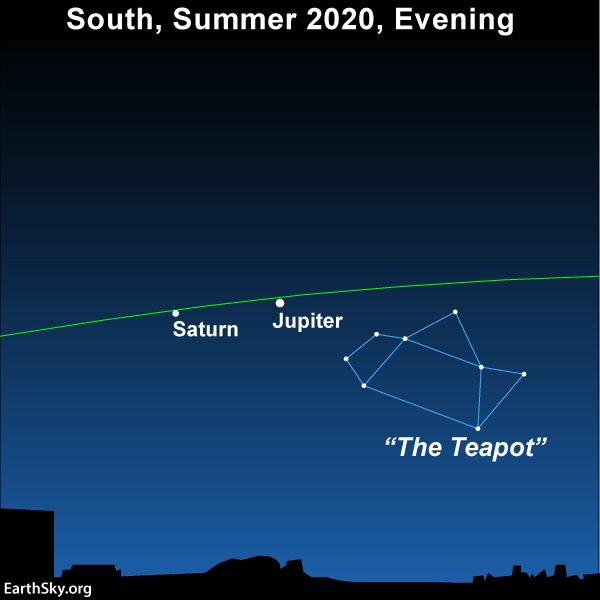
If you notice just one object in the sky after sunset, it might be very bright Jupiter. This planet outshines all the stars, plus it’s near another bright planet, Saturn. You can’t miss these two. Jupiter and Saturn are highest up for the night at nightfall. Before 2020 ends, Jupiter and Saturn will undergo a great conjunction.
Mars lords over the eastern sky as darkness falls in November. Its fiery-red splendor lights up the nighttime for most of the night. In October 2020, Mars was brighter than it will be again until September 2035. That’s because – on October 13, 2020 – Mars reached opposition in our sky, when it was opposite the sun as seen from Earth. At opposition, Earth was sweeping between Mars and the sun. Now – in its smaller, faster orbit – Earth is now rushing along, leaving Mars behind. Thus, in the months ahead, Mars will slowly but surely dim in our nighttime sky.
Let the moon help guide your eye to Mars for several nights centered on or near October 29, and then watch again for another several nights in the last week of November, centered on or near November 25.
Read more: Blue Moon and red Mars on Halloween!

View at EarthSky Community Photos. | From Paul Armstrong, who took this photo of Mars, Saturn and Jupiter on the morning of April 15, 2020, from Exmoor, U.K. Jupiter is at the upper right, Mars at center left, with Saturn between them. In May 2020, Jupiter and Saturn were closer together, whereas Mars was farther away from Jupiter and Saturn. Thanks, Paul!
Venus – the brightest planet – reached its greatest elongation from the sun in the morning sky on August 12 or 13 (depending upon your time zone). But dazzling Venus will remain bright and beautiful as a morning “star” for the rest of this year.
At mid-northern latitudes, Venus rises about 3 hours before the sun in early November, tapering down to about 2 1/2 hours by the month’s end.
At and near the equator, Venus rises 2 hours before the sun in early October, decreasing to 1 5/6 hours at the month’s end.
At temperate latitudes in the Southern Hemisphere, Venus rises about 1 1/2 hours before the sun throughout the month.
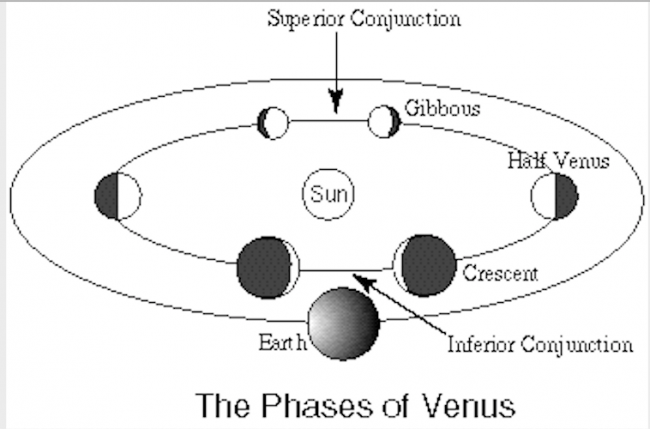
Inferior conjunction – when Venus sweeps between the sun and Earth – happened on June 3, 2020. Some 10 weeks later, Venus reached its greatest elongation in the morning sky on August 13, 2020 (when its disk was about 50% illuminated by sunshine). In November 2020, Venus will start the month about 81% illuminated and then end the month about 88% illuminated. Image via UCLA.
Throughout November, Venus in its faster orbit around the sun will be going farther and farther away from Earth. As viewed through the telescope, Venus’ waxing gibbous phase will widen, yet its overall disk size will shrink. Venus’ disk is 81% illuminated in early November, and 88% illuminated by the month’s end; Venus’ angular diameter, on the other hand, will shrink to about 89% of its initial size by late November.
Watch for the waning crescent moon to shine with Venus (and Mercury) in the morning sky for several days, centered around November 12 or 13.
Mercury showcases a fine morning apparition for the Northern Hemisphere during the first several weeks of November 2020. Moreover, the dazzling planet Venus serves as your guide “star” to Mercury, which looms closer to the horizon. Mercury reaches its greatest morning elongation of 19 degrees west of the sun on November 10, yet remains at least 18 degrees west of the sun from November 5 to 16, 2020. Be sure to view the waning crescent moon joining up with these two worlds for several days, centered around November 12 or 13, 2020.
What do we mean by bright planet? By bright planet, we mean any solar system planet that is easily visible without an optical aid and that has been watched by our ancestors since time immemorial. In their outward order from the sun, the five bright planets are Mercury, Venus, Mars, Jupiter and Saturn. These planets actually do appear bright in our sky. They are typically as bright as – or brighter than – the brightest stars. Plus, these relatively nearby worlds tend to shine with a steadier light than the distant, twinkling stars. You can spot them, and come to know them as faithful friends, if you try.
Bottom line: November 2020 presents 3 bright planets in the evening sky: Mars, Jupiter and Saturn, plus 2 bright planets in the morning sky: Venus and Mercury.
Don’t miss anything. Subscribe to EarthSky News by email
Visit EarthSky’s Best Places to Stargaze to find a dark-sky location near you.
Help EarthSky keep going! Donate now.
Post your planet photos at EarthSky Community Photos.
from EarthSky https://ift.tt/1YD00CF

Click the name of a planet to learn more about its visibility in November 2020: Jupiter, Saturn, Mars, Venus, Mercury
Try Stellarium for a precise view of the planets from your location.
Want precise planet rise and set times? Click here for recommended almanacs

Depending on where you live on Earth’s globe, the October 31 full moon will be either the second of 2 October full moons (most everywhere worldwide) or the first of 2 November full moons (Eastern Australia and New Zealand). The second of 2 full moons in a single calendar month is called a Blue Moon. Read more.

The first few weeks in November 2020 present a grand time to catch the planet Mercury beneath the brightest planet of them all: Venus. Read more.

Starting around November 10, 2020, the illuminated side of the waning crescent moon points to the two morning planets, Venus (at top) and Mercury (at bottom). Read more.

The waning crescent moon won’t ruin the North Taurid meteor shower on the expected peak night of November 11-12, 2020. But it’ll certainly be a treat to view the slender waning crescent moon with the planets Venus and Mercury! Read more.

Watch for the waxing crescent moon to shine in the neighborhood of Jupiter and Saturn for several days, centered on or around November 19, 2020. Read more.

Use the bright waxing gibbous moon to locate Mars for several nights, centered on or near November 25, 2020. Read more.
Jupiter and Saturn come out first thing at nightfall in November 2020, and will continue to do so until the year’s end. They are near one another on the sky’s dome, with Saturn following Jupiter westward across the sky from nightfall until their setting below the southwest horizon.
At mid-northern latitudes, Jupiter and Saturn set at mid-evening; and from the Southern Hemisphere, they stay out till late night.
For the first time since the year 2000, Jupiter and Saturn will have a great conjunction this year, in December 2020. Great conjunctions of these two giant worlds happen every 20 years, but this year’s event will be the closest of Jupiter-Saturn conjunctions since the year 1623. Astronomers use the word conjunction to describe meetings of planets and other objects on our sky’s dome. They use the term great conjunction to describe a meeting of Jupiter and Saturn. The last great Jupiter-Saturn conjunction was May 28, 2000. The next one will be December 21, 2020. Watch for these worlds to edge closer and closer together throughout November 2020.
Read more: Before 2020 ends, a great conjunction for Jupiter and Saturn
These two worlds appear bright and beautiful throughout November. Day by day, they’ll sink a bit lower in the sky at sunset, and set sooner after dark.
If you have a telescope, it’s best to use it when Jupiter and Saturn are highest up for the night at nightfall. These two worlds will descend westward as evening deepens, so catch them early. Typically, the view of Jupiter’s four major moons and Saturn’s glorious rings through the telescope is sharper when these worlds are higher up than lower down. The thickness of the Earth’s atmosphere near the horizon tends to blur the view of Jupiter’s moons and Saturn’s rings.
Positions of Jupiter’s moons via Sky & Telescope
Look first for brilliant Jupiter; Saturn is the bright object immediately to Jupiter’s east. Although Saturn is easily as bright as a 1st-magnitude star – as bright as the brightest stars in our sky – the ringed planet can’t compete with the the king planet Jupiter, which outshines Saturn by some 12 times. After all, Jupiter almost always ranks as the fourth brightest celestial object, after the sun, the moon and the planet Venus, respectively (although Mars temporarily reigned as the fourth-brightest celestial body – and Jupiter as the fifth-brightest – in October 2020).
Watch for the moon in the neighborhood of Jupiter and Saturn for several days, centered on or near November 19.

If you notice just one object in the sky after sunset, it might be very bright Jupiter. This planet outshines all the stars, plus it’s near another bright planet, Saturn. You can’t miss these two. Jupiter and Saturn are highest up for the night at nightfall. Before 2020 ends, Jupiter and Saturn will undergo a great conjunction.
Mars lords over the eastern sky as darkness falls in November. Its fiery-red splendor lights up the nighttime for most of the night. In October 2020, Mars was brighter than it will be again until September 2035. That’s because – on October 13, 2020 – Mars reached opposition in our sky, when it was opposite the sun as seen from Earth. At opposition, Earth was sweeping between Mars and the sun. Now – in its smaller, faster orbit – Earth is now rushing along, leaving Mars behind. Thus, in the months ahead, Mars will slowly but surely dim in our nighttime sky.
Let the moon help guide your eye to Mars for several nights centered on or near October 29, and then watch again for another several nights in the last week of November, centered on or near November 25.
Read more: Blue Moon and red Mars on Halloween!

View at EarthSky Community Photos. | From Paul Armstrong, who took this photo of Mars, Saturn and Jupiter on the morning of April 15, 2020, from Exmoor, U.K. Jupiter is at the upper right, Mars at center left, with Saturn between them. In May 2020, Jupiter and Saturn were closer together, whereas Mars was farther away from Jupiter and Saturn. Thanks, Paul!
Venus – the brightest planet – reached its greatest elongation from the sun in the morning sky on August 12 or 13 (depending upon your time zone). But dazzling Venus will remain bright and beautiful as a morning “star” for the rest of this year.
At mid-northern latitudes, Venus rises about 3 hours before the sun in early November, tapering down to about 2 1/2 hours by the month’s end.
At and near the equator, Venus rises 2 hours before the sun in early October, decreasing to 1 5/6 hours at the month’s end.
At temperate latitudes in the Southern Hemisphere, Venus rises about 1 1/2 hours before the sun throughout the month.

Inferior conjunction – when Venus sweeps between the sun and Earth – happened on June 3, 2020. Some 10 weeks later, Venus reached its greatest elongation in the morning sky on August 13, 2020 (when its disk was about 50% illuminated by sunshine). In November 2020, Venus will start the month about 81% illuminated and then end the month about 88% illuminated. Image via UCLA.
Throughout November, Venus in its faster orbit around the sun will be going farther and farther away from Earth. As viewed through the telescope, Venus’ waxing gibbous phase will widen, yet its overall disk size will shrink. Venus’ disk is 81% illuminated in early November, and 88% illuminated by the month’s end; Venus’ angular diameter, on the other hand, will shrink to about 89% of its initial size by late November.
Watch for the waning crescent moon to shine with Venus (and Mercury) in the morning sky for several days, centered around November 12 or 13.
Mercury showcases a fine morning apparition for the Northern Hemisphere during the first several weeks of November 2020. Moreover, the dazzling planet Venus serves as your guide “star” to Mercury, which looms closer to the horizon. Mercury reaches its greatest morning elongation of 19 degrees west of the sun on November 10, yet remains at least 18 degrees west of the sun from November 5 to 16, 2020. Be sure to view the waning crescent moon joining up with these two worlds for several days, centered around November 12 or 13, 2020.
What do we mean by bright planet? By bright planet, we mean any solar system planet that is easily visible without an optical aid and that has been watched by our ancestors since time immemorial. In their outward order from the sun, the five bright planets are Mercury, Venus, Mars, Jupiter and Saturn. These planets actually do appear bright in our sky. They are typically as bright as – or brighter than – the brightest stars. Plus, these relatively nearby worlds tend to shine with a steadier light than the distant, twinkling stars. You can spot them, and come to know them as faithful friends, if you try.
Bottom line: November 2020 presents 3 bright planets in the evening sky: Mars, Jupiter and Saturn, plus 2 bright planets in the morning sky: Venus and Mercury.
Don’t miss anything. Subscribe to EarthSky News by email
Visit EarthSky’s Best Places to Stargaze to find a dark-sky location near you.
Help EarthSky keep going! Donate now.
Post your planet photos at EarthSky Community Photos.
from EarthSky https://ift.tt/1YD00CF


Aucun commentaire:
Enregistrer un commentaire